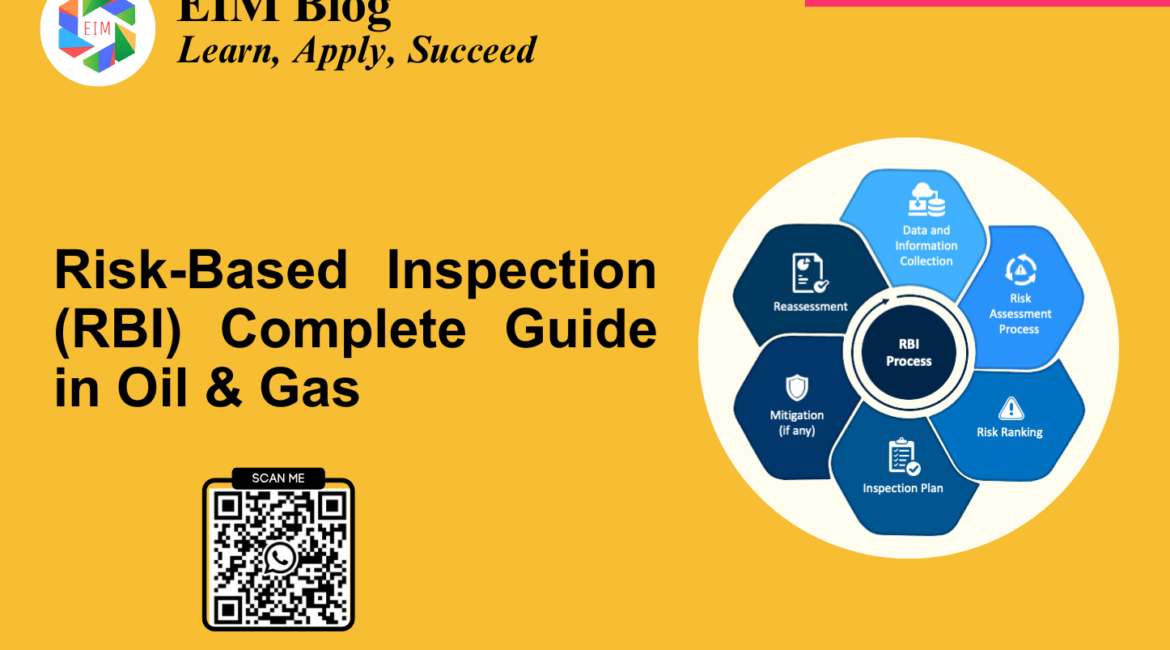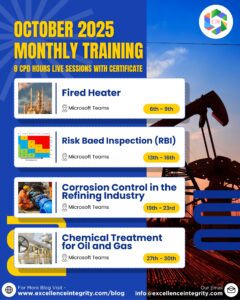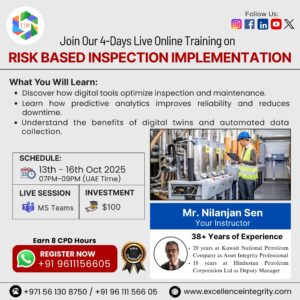
Risk-Based Inspection (RBI) in Oil & Gas: A Complete Guide
1. Introduction
In industries such as oil and gas, chemical processing, power generation, and manufacturing, ensuring asset reliability and operational safety is a constant priority. Traditional time-based inspection schedules often lead to unnecessary downtime, unplanned outages, or missed failure indicators.
Risk-Based Inspection (RBI) offers a smarter alternative — a data-driven, structured methodology that prioritizes inspections based on actual risk instead of fixed intervals. This not only enhances asset integrity management but also optimizes costs and resources.
In this article, we’ll explore:
-
What RBI is and why it matters
-
How RBI is implemented
-
The technologies transforming RBI
-
Practical steps and industry examples
-
FAQs and future trends shaping the next generation of inspections
2. What is Risk-Based Inspection (RBI)?
Risk-Based Inspection (RBI) is a systematic process that evaluates the Probability of Failure (PoF) and Consequence of Failure (CoF) for critical equipment — such as pipelines, pressure vessels, heat exchangers, and reactors.
Unlike traditional approaches where all assets receive equal inspection attention, RBI directs focus and resources toward high-risk components, resulting in improved efficiency, safety, and compliance.
Key Objectives of RBI
-
Optimize inspection intervals and frequency
-
Focus efforts on assets with the highest failure potential
-
Enhance operational safety and regulatory compliance
-
Reduce maintenance costs and downtime
3. Core Components of RBI Implementation
a. Risk Assessment
Evaluate each asset’s age, material, operating conditions, corrosion rate, pressure, and maintenance history.
Risk is determined as:
Risk = Probability of Failure (PoF) × Consequence of Failure (CoF)
-
PoF: Likelihood of asset failure based on data, environment, and design.
-
CoF: The severity of potential outcomes — safety, environmental, financial, and reputational impacts.
b. Inspection Strategies
Design customized inspection plans emphasizing high-risk equipment while optimizing intervals for low-risk assets.
Modern RBI leverages:
-
Non-Destructive Testing (NDT) techniques
-
Corrosion monitoring sensors
-
Condition-based and real-time monitoring systems
c. Maintenance and Continuous Monitoring
Inspection results fuel predictive maintenance programs, ensuring early intervention before failure occurs.
-
Low-risk assets: routine monitoring
-
High-risk assets: immediate corrective action
Example:
A petrochemical plant increased uptime by 25% and reduced unscheduled shutdowns by 40% after integrating RBI with IoT-based condition monitoring.
d. Iterative Reassessment & Planning
RBI is not a one-time activity. Risk profiles evolve as equipment ages or processes change.
Regularly review and update your risk assessments using the latest inspection, performance, and operational data.
4. Benefits of Risk-Based Inspection
| Benefit | Impact |
|---|---|
| Optimized Resource Allocation | Focus on critical assets for maximum inspection value |
| Enhanced Safety | Early detection prevents accidents and failures |
| Reduced Downtime | Enables planned, predictive maintenance |
| Extended Asset Life | Preventive measures increase equipment longevity |
| Regulatory Compliance | Aligns with API 580/581 and ISO 14224 standards |
5. Challenges and Solutions in Implementing RBI
| Challenge | Solution & Best Practice |
|---|---|
| Poor Data Quality | Standardize asset data, digitize inspection records, install smart sensors |
| High Initial Cost | View as long-term investment; quantify ROI through reduced downtime |
| Resistance to Change | Conduct training workshops, secure management buy-in |
| Evolving Risk Profiles | Perform periodic reviews and update methodologies |
6. Step-by-Step Guide: Implementing RBI
-
Conduct Risk Assessment
Use RBI tools/software to evaluate PoF and CoF. -
Develop Inspection Strategies
Prioritize assets, set inspection intervals, select NDT methods. -
Implement Monitoring & Maintenance
Integrate IoT devices and analytics for live data tracking. -
Review & Refine
Analyze inspection data, adjust risk matrix, and update plans. -
Train Personnel
Provide continuous training in RBI methodology, mechanical integrity, and safety.
7. Industries Benefiting from RBI
-
Oil & Gas: Refineries, pipelines, storage tanks, offshore platforms
-
Chemical: Reactors, pressure vessels, heat exchangers
-
Power Generation: Boilers, turbines, condensers
-
Manufacturing: Heavy machinery, automated systems
8. Advanced Technologies Transforming RBI
| Technology | Role in RBI |
|---|---|
| Artificial Intelligence (AI) & Machine Learning (ML) | Analyze inspection history and predict future failures |
| Digital Twins | Simulate equipment behavior and optimize inspection schedules |
| IoT Sensors | Provide continuous real-time asset health data |
| Predictive Analytics | Forecast degradation and maintenance needs |
| Cloud-Based Platforms | Centralize inspection data for collaboration and compliance audits |
9. Frequently Asked Questions (FAQ)
Q1: What is PoF and CoF in RBI?
A: PoF (Probability of Failure) measures how likely an asset is to fail; CoF (Consequence of Failure) measures how severe that failure would be.
Risk = PoF × CoF
Q2: How do I choose between qualitative and quantitative RBI?
Use qualitative for limited data or simple systems; quantitative for complex, high-value assets.
Q3: Which standards guide RBI programs?
Follow API 580, API 581, and ISO 14224 for international best practices.
Q4: How often should RBI assessments be updated?
After every major inspection, asset modification, or regulatory update.
Q5: Are RBI checklists available?
Yes, several organizations offer downloadable RBI compliance checklists for program initiation.
10. Future of RBI: The Road Ahead
The future of RBI lies in digital integration and automation.
Emerging technologies such as cloud-based analytics, remote drones, generative AI, and predictive modeling are revolutionizing how inspections are conducted. These advancements enable real-time, autonomous, and cost-efficient asset management — transforming maintenance from reactive to predictive.
11. Conclusion
Risk-Based Inspection (RBI) is no longer just an optional methodology — it’s a strategic pillar for industries seeking to improve reliability, safety, and cost efficiency.
By integrating data analytics, digital tools, and predictive maintenance, organizations can:
-
Minimize unplanned shutdowns
-
Extend asset life
-
Enhance compliance and sustainability





Luann
Thanks for finally writing about > Risk-Based Inspection (RBI) in Oil
& Gas: A Complete Guide < Loved it!